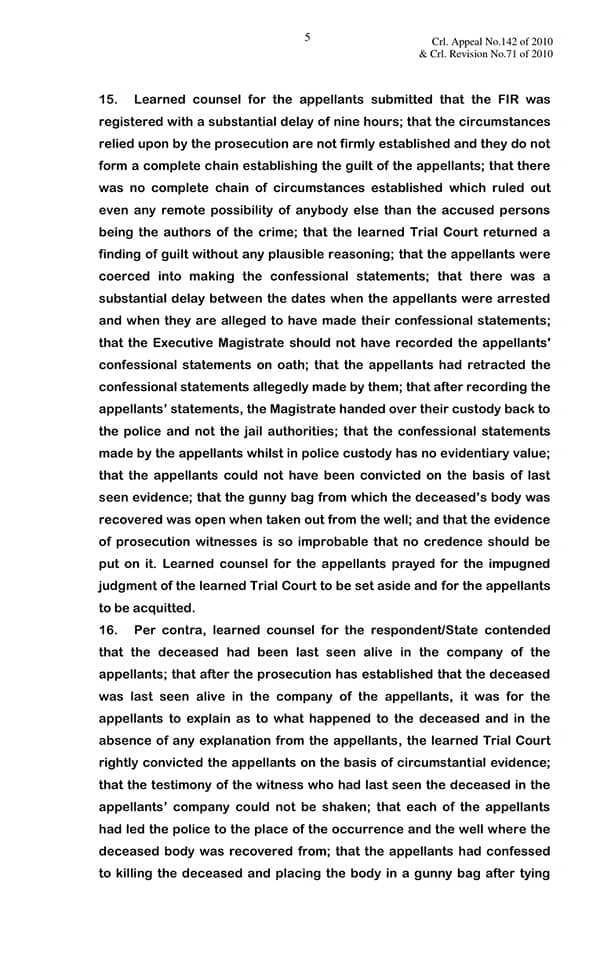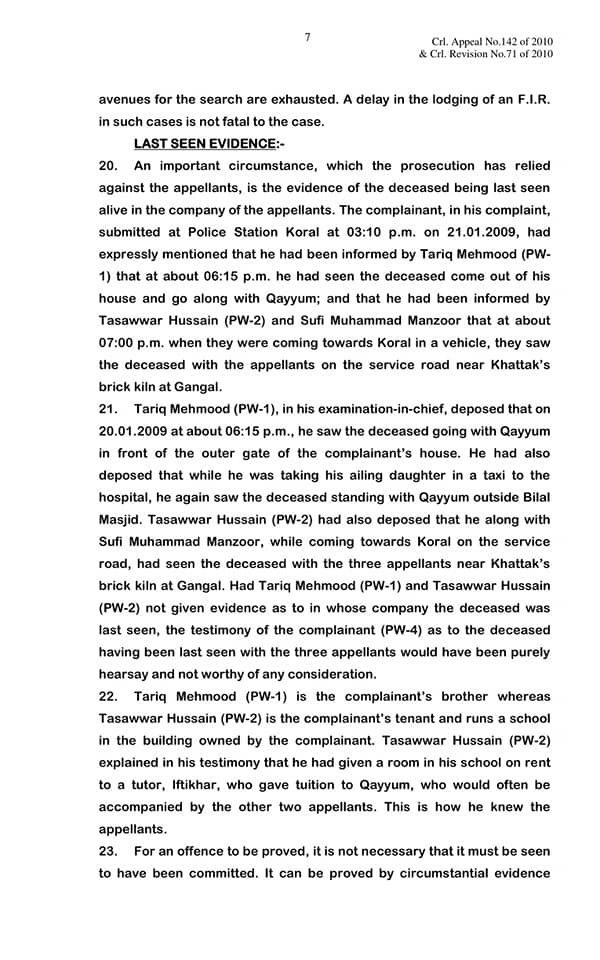For an offence to be proved, it is not necessary that it must be seen to have been committed. It can be proved by circumstantial evidence also. The factum probandum (the principal fact) may be proved indirectly by means of certain inferences drawn from factum probans (the evidentiary facts). Circumstantial evidence consists of evidence of facts that are so closely associated with the fact in issue that considered together they form a chain of circumstances from which the existence of the principal fact can be legally inferred or presumed. It has consistently been held that where a case rests squarely on circumstantial evidence, the inference of guilt can be justified only when all the incriminating facts and circumstances are found to be incompatible with the innocence of the accused or the guilt of any other persons. Great care must be taken in evaluating circumstantial evidence and if the evidence relied on is reasonably capable of two inferences, the one in favour of the accused must be accepted. The circumstances from which an inference as to the guilt of the accused is drawn have to be proved beyond reasonable doubt and have to be shown to be closely connected with the principal fact sought to be inferred from those circumstances. The cumulative effect of all the facts so established must be consistent only with the hypothesis of guilt. Where the case depends upon the conclusion drawn from circumstances, the cumulative effect of the circumstances must be such as to negative the innocence of the accused.
The necessary conditions for the application of Section 34 P.P.C. are common intention to commit an offence and participation by all the accused in doing an act or acts in furtherance of that common intention. If these two ingredients are established, all the accused would be liable for the offence.
Pak Case Laws
October 07, 2021
The "last seen evidence" is one of the categories of circumstantial evidence. The legal obligations which the prosecution are required to fulfill where a case is sought to be made on the basis of last seen evidence were enumerated in the said judgment. It was held inter alia that “the proximity of the crime scene plays a vital role because if within a short distance the deceased is done to death then, ordinarily the inference would be that he did not part ways or separated from the accused and onus in this regard would shift to the accused to furnish those circumstances under which, the deceased left him and parted ways in the course of transit.”The last-seen theory comes into play where the time gap between the point of time when the accused and the deceased were last seen alive and the deceased is found dead is so small that possibility of any person other than the accused being the author of the crime becomes impossible.
Article 37 of the Qanun-e-Shahadat Order, 1984 (“the 1984 Order”) provides that a confession made by an accused person is irrelevant in a criminal proceeding, if the making of the confession appears to the Court to have been caused by any inducement, threat or promise having reference to the charge against the accused person, proceeding from a person in authority and sufficient, in the opinion of the Court, to give the accused person grounds which would appear to him reasonable for supposing that by making it he would gain any advantage or avoid any evil of a temporal nature in reference to the proceeding against him. Furthermore, Article 39 of the 1984 Order provides that subject to Article 40, no confession made by any person whilst he is in the custody of a police officer, unless it shall be made in the immediate presence of a Magistrate, shall be proved against such person.
Article 40 of the 1984 Order, which is an exception to Article 39, provides that when any fact is deposed to as discovered in consequence of information received from a person accused of any offence, in the custody of a police officer, so much of such information, whether it amounts to a confession or not, as relates distinctly to the fact thereby discovered, may be proved.
The statement of an accused regarding facts which are already in the knowledge of the police or any other person does not fall within the purview of Article 40 but Article 39 of the 1984 Order. However, a statement made by an accused in police custody can be taken into consideration only if it leads to the discovery of a fact which was not previously known to anybody. In the instant case, there is nothing on the record to show that prior to the disclosure made by Qayyum and the pointation of the well from where the deceased’s body was recovered was known to any other person. Since Article 39 of the 1984 Order is subject to Article 40, the information disclosed by appellant, even though whilst in police custody, as to the place where the deceased’s body was thrown by the appellants, can be relied upon.
Section 34 P.P.C. does not create a distinct offence but lays down the principle of joint criminal liability. The necessary conditions for the application of Section 34 P.P.C. are common intention to commit an offence and participation by all the accused in doing an act or acts in furtherance of that common intention. If these two ingredients are established, all the accused would be liable for the offence. That is to say, if two or more persons had common intention to commit murder and they had participated in the acts done by them in furtherance of that common intention, all of them would be guilty of murder. It is well established that common intention presupposes prior concert. It requires a pre-arranged plan because before a person can be vicariously convicted for the criminal act of another, the act must have been done in furtherance of the common intention of all of them. The plan need not be elaborate nor is a long interval of time required. It could arise and be formed suddenly. There must have been a prior meeting of minds.
For a judicial confession, whether later retracted or not, to form the basis of a conviction, it must first be tested whether the confession is voluntary and truthful inculpating the accused in the commission of the crime. For a confession to be proved to have been made voluntarily, the Court has to satisfy itself that all the prerequisites under Section 164 Cr.P.C. had been fulfilled. Where such conditions are fulfilled, the mere fact that a confession is retracted by the accused would not ipso facto denude it of its evidentiary value.
The Rules and Orders of the Lahore High Court, which applicable in the Islamabad Capital Territory at the relevant time, prescribe the mode and manner in which the Magistrate is to record the confessional statement of an accused under Section 164 Cr.P.C. The Memorandum of the Inquiry by the Magistrate must show that it has been explained to the accused that he is not bound to make a confession, and that if he does so, it may be used as evidence against him. The Magistrate can also put such further questions to the accused as may be necessary to enable him to judge whether he is acting voluntarily. In arriving at his conclusion that the confession is being made voluntarily, the Magistrate is required to consider inter alia the period during which the accused has been in police recorded by a Magistrate and that if he makes a confession, it may be used as evidence against him; that he is making a statement voluntarily; and that after making a statement before the Magistrate, he will not be remanded to police custody but will be sent to judicial lock-up. The Magistrate is required to specifically ask the accused whether he is making a statement voluntarily, and his reasons for wishing to make a statement. custody. Furthermore, the Magistrate is required to make sure that the confession is not a result of any undue influence or ill treatment. The Magistrate is required to ask the accused whether he understands that he is not bound to make a confession; that his statement is being recorded by a Magistrate and that if he makes a confession, it may be used as evidence against him; that he is making a statement voluntarily; and that after making a statement before the Magistrate, he will not be remanded to police custody but will be sent to judicial lock-up. The Magistrate is required to specifically ask the accused whether he is making a statement voluntarily, and his reasons for wishing to make a statement.
You may like these posts
Ad Space
Popular Posts
Labels
Tags
- 109 PPC
- 123 PPC
- 124 PPC
- 132 PPC
- 133 PPC
- 133 QSO
- 134 CrPC
- 148 PPC
- 149 PPC
- 154 CrPC
- 161 Cr.P.C
- 161 CrPC
- 161 PPC
- 164 Cr.P.C
- 170 CrP.C.
- 172 CrPC
- 177
- 179 & 180 CR.P.C.
- 185 COP
- 190 CrPC
- 193 & 202 CR.P.C.
- 193 CrPC
- 193 QSO
- 199 COP
- 1997 (XXV of 1997)
- 1997 (XXVII of 1997)
- 200 CrPC
- 201 PPC
- 2014 (XX of 2014)
- 204 CrPC
- 22-A
- 22-B
- 22A CrPC
- 265c CrPC
- 295 c PPC
- 300 PPC
- 302 b PPC
- 302 c PPC
- 302 PPC
- 304 PPC
- 307 PPC
- 323 PPC
- 324 PPC
- 325 PPC
- 326 PPC
- 34 PPC
- 342 CrPC
- 344 Cr.P.C.
- 345 CrPC
- 36 CrPC
- 376 PPC
- 379 CrPC
- 380 PPC
- 381 A PPC
- 392 PPC
- 397 PPC
- 406 PPC
- 409 PPC
- 411 PPC
- 417 CrPC
- 419 PPC
- 420 PPC
- 428 CrPC
- 435 CrPC
- 435 PPC
- 439 CrPC
- 440 PPC
- 448 PPC
- 454 PPC
- 46 QSO
- 467 PPC
- 468 PPC
- 471 PPC
- 491 PPC
- 497 Cr.P.C.
- 497 CrPC
- 497 PPC
- 497(2)
- 498 CrPC
- 498 F PPC
- 4Cr.P.C. 63 Cr.P.C
- 511 PPC
- 528 CrPC
- 540 CrPC
- 561 CrPC
- 91 CrPC
- 96 PPC
- 97 PPC
- accused acquitted
- AMENDMENT
- and 149 PPC
- Anti-Terrorism Act
- Art. 185(3))
- bai
- Bail
- Bail Granted
- Benefit of doubt
- cas
- Case Law with Complete Judgment
- Case Laws
- Child Witness
- Constitution of Pakistan (1973)
- Control of Narcotic Substances Act
- Conviction
- Corruption Act S.5
- Cr.P.C
- Cr.P.C.
- CrPC
- CrPC 439
- CrPcC 103
- Delay in FIR
- Draft/Application
- Evidance
- Evidence
- Extra-Judicial Confession
- Financial Institutions
- Gazette
- Identification prade
- Important Judgment
- limitation
- Marginal Wittness
- Murder
- Police Rules (1934)
- Prohibition (Enforcement of Hadd) Order (4 of 1979)‑
- Punjab Overseas Commission Act
- Qanun-e-Shahadat (10 of 1984)
- Recovery
- Revision
- S=9
- SECTION 169 Cr.P.C.
- SECTION 173 CR.P.C.
- Section 24
- Section 489-F PPC.
- SECTION 63 Cr.P.C.
- SECTIONS 190
- SECTIONS 2
- The talk of the town
- Topic
- Topics
- Urdu Video
- Video
- Witness
- witness statement
Popular Posts
Labels
Menu Footer Widget
Created By Blogger Template | Distributed By Gooyaabi Template

































0 Comments